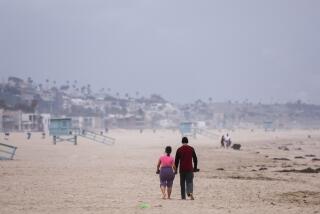Icy Pea Soup Makes Alaska City Spooky, Travel Risky
- Share via
FAIRBANKS, Alaska — Alaska’s big chill, now in its third week and only gradually fading as a high pressure front moves south, has triggered an atmospheric side effect, ice fog, that has wrapped Fairbanks in a murky blanket and often reduced visibility to near zero.
“It’s spooky out there,” said Harry Hutchinson, whose Chevron service station has been kept busy by a rash of fender-benders.
Officials in this community of 22,000--the northernmost major city in North America--say that the fog has been an even greater menace to public safety than the temperatures of 50 degrees below zero and lower.
Public schools and offices were closed earlier this week, not because it was too cold for people to get out of the house but because the fog--literally microscopic crystals of ice suspended in air--was so dense that it was too dangerous for them to drive to work or school.
Thursday, although the Alaskan high pressure system had spread the cold throughout the Midwestern United States, the crisis continued here. Gov. Steve Cowper declared northwest Alaska villages where water and sewer systems have frozen to be a disaster area.
Brian Phillips, the Fairbanks city manager, said Wednesday that, if the fog thickened, authorities were prepared to declare a civil emergency and restrict traffic to essential travel or emergency vehicles only. “We’re concerned about motorists’ knocking down power poles and a possible interruption of power service,” he said.
Ice fog differs in both structure and behavior from the kind of pea soup that residents of more temperate climates are used to. For one thing, ice fog does not necessarily burn off as the sun rises. But, to the untrained eye, the two varieties of fog appear pretty much the same.
At minus 40 degrees or lower, a process called “spontaneous nucleation” occurs that freezes super-cooled droplets of water vapor. The process can take place at higher temperatures if there are pollutants or dust particles, which tend to bind to the ice crystals.
Ted Fathauer, the chief meteorologist for the National Weather Service here, said that small patches of ice fog often linger along hot springs and rivers out in the wilderness and have even been seen trailing herds of caribou as the vapor from their breath freezes.
But it is in low-lying settlements, particularly large ones like Fairbanks, where the phenomenon is most pronounced, because vehicles and heating systems release both pollutants and water vapor as a product of combustion.
“If you turned off all the furnaces, the cars, the power plant and moved the people out, then, in a few days, the ice fog would be gone,” Fathauer said.
Ice fog had not posed much of a problem here for several years because winters have been unusually warm over the last decade. But, in the intervening period, the metropolitan area had grown, increasing the odds of a prolonged ice fog attack when a major cold snap finally hit.
Aggravating the problem has been a temperature inversion that has trapped the coldest air near ground level. While Fairbanks has been shrouded in fog for weeks, higher elevations a few miles outside of town have had warmer temperatures and pristine visibility.
Tom Hyatt, regional manager of the bus company that transports children to classes, said schools were ordered closed on Monday and Tuesday because drivers could not see other vehicles and were afraid of being rear-ended when they stopped to pick up youngsters. Before the shutdown, Hyatt said, buses moved only at a crawl, and drivers often realized that they were approaching a stop only when they saw the legs of children in their low beams.
“Trying to drive in that mentally wears you out until you are physically fatigued as well,” said Hyatt.
The fog has even made shut-ins out of those who are old hands at coping with extreme cold.
In North Pole, a suburb that has been even foggier and colder than Fairbanks, Nancy Claus said she has been reluctant to venture far from home. “You can only drive about 10 m.p.h. and, if you do happen to stop, it can be real dangerous,” said Mrs. Claus, a widow who lives alone.
More to Read
Sign up for Essential California
The most important California stories and recommendations in your inbox every morning.
You may occasionally receive promotional content from the Los Angeles Times.













